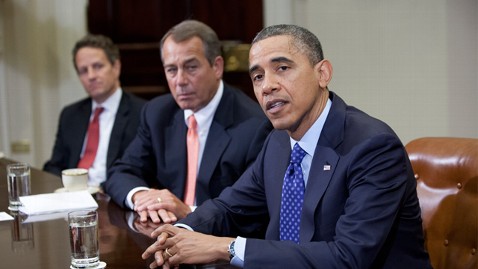
(KEVIN DIETSCH/POOL/EPA)
“Working with Democrats and Republicans last year, we were able to cut over a trillion dollars of spending — the largest cut, by the way, in discretionary spending in history.”
— President Obama, remarks to the Business Roundtable, Dec. 5, 2012
To some extent, it is a bit silly for politicians to claim they have achieved the “biggest” or “largest” event in history because it simply invites more scrutiny.
Our ears perked up when President Obama made this claim on Wednesday to a group of corporate chieftains. It was reminiscent of a claim he had previously made concerning a $38.5 billion cut in the fiscal 2011 budget, which he had called “the largest annual spending cut in our history.”
Republicans at the time also made similar claims and The Washington Post even had a front-page headline that declared “Biggest Cuts in U.S. History.” None of that turned out to be correct, especially when inflation-adjusted dollars were considered. We awarded Two Pinocchios to the media for failing to provide the right context for the comments of politicians.
But in April 2011, Obama was referring to a year-over-year reduction in actual dollars. In this case, Obama is referring to the subsequent Budget Control Act, which ended the impasse over raising the debt ceiling by seeking to reduce the deficit over a 10-year period. In other words, that $1 trillion that the president mentioned is a reduction from previous budget targets — what is known as the budget baseline.
Let’s take a closer look.
The Facts
As we noted before, when making comparisons over many years, inflation must always be considered. The price of retail gasoline was about 25 cents in 1918, which sounds much better than the average of $3.64 this year. But, inflation-adjusted, the price of gasoline in 1918 was actually higher — $3.83
Similarly, there have been some years when government spending has been cut dramatically. After World Wars I and II, the budget was slashed so quickly and dramatically within three years that it makes $1 trillion in projected spending over 10 years look like peanuts.
Inflation-adjusted, the federal outlays were actually cut by $2 trillion in just three years after World War I and by $1.5 trillion over three years after World War II, according to the historical tables of the federal budget. (We use outlays from the historical tables because that shows what was actually spent.)
Obama specifically mentioned discretionary spending — what is annually appropriated by Congress. (“Mandatory spending,” such as for health programs, is on automatic pilot unless laws are changed.) The historical tables only offer details on discretionary spending since 1962, though obviously the war spending in earlier years was discretionary. In raw numbers, we find only seven years when actual spending declined from year to year though 2017.
Obviously, the years 2013 through 2017 are estimates and to keep things simple we will use the numbers in Obama’s 2013 budget; the estimates change slightly in the mid-session review. But in both cases, discretionary spending begins to increase, in nominal terms, in the later part of the decade.
But Obama’s claim looks better when viewed through the prism of inflation-adjusted numbers. This is especially important in the context of the federal budget.
For instance, Defense spending technically remained constant from 1987 to 1994 — $282 billion a year. But look what happened to the military during those seven years: The number of troops fell from 2.2 million to 1.6 million, the number of Army divisions was slashed from 28 to 20, Air Force fighter wings dropped from 36 to 22 and Navy fighting ships declined from 568 to 387. That’s because inflation over time ate away at the value of those dollars. By most measures, defense spending was trimmed, though in theory, not a penny was cut.
Inflation-adjusted (constant 2005 dollars in the budget documents), we find many more years when the discretionary spending shrank.
For instance, in the six years between 1968 and 1974, discretionary spending fell 21.6 percent. In the five-year period between 1991 and 1996, discretionary spending fell 12 percent.
Meanwhile, Obama’s projected budget shows that in the six-year period ending 2017, discretionary spending would fall 22.7 percent — about $265 billion in constant 2005 dollars.
That’s the biggest six-year cut since 1962, though not in history. The federal budget fell 84 percent in inflation-adjusted dollars in the six years after World War I and 66 percent in the six years after World War II.
There is a certain irony, of course: Obama was forced into accepting many of these cuts — after Republicans forced a bitter fight over extending the debt ceiling. But to his credit, he also cited Republicans when making his statement.
The Pinocchio Test
Obama appears to be mixing up baseline cuts (“a trillion dollars”) with actual reductions in discretionary spending, thus making the numbers appear bigger than reality.
But it turns out that the White House, working with Congress, has scheduled a reduction in discretionary spending that, accounting for inflation, would be the biggest six-year decline in the last half century.
But, by significant percentages, it is a far cry from the biggest in history — the central part of Obama’s claim.
Moreover, we can’t help but note that back in 2011, Obama justified a similar claim by citing non-inflation adjusted dollars. By that lesser standard, discretionary spending is essentially flat after six years.
Two Pinocchios

(About our rating scale)
Check out our candidate Pinocchio Tracker
Follow The Fact Checker on Twitter and friend us on Facebook
.





















